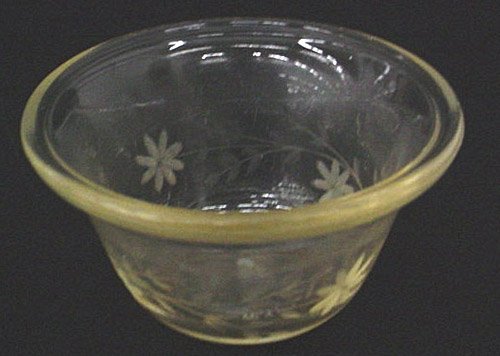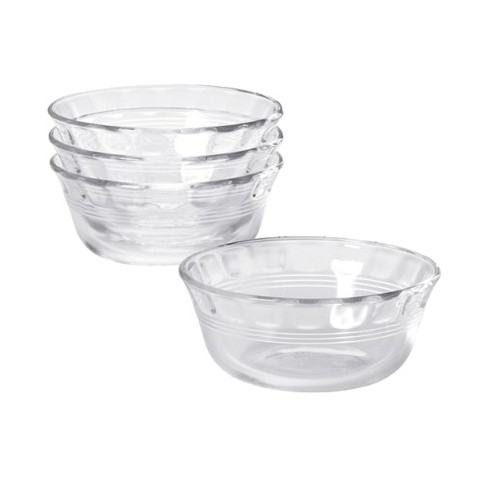
This could be very difficult to do properly. In other words, what is generally more important is having enough cups to divide up all your batter or other ingredients into so you don’t have to try to adjust recipes to suit the amount of space you have. So, the problem is that if you have a recipe that calls for filling six 8-ounce cups and all you have is six 4-ounce cups, you will have leftover batter. For souffles, cooks generally fill the cups all the way to the top or leave around an inch or a little less space. Well, for most recipes, you can easily choose between 4-ounce and 6-ounce sized ramekins.
Pyrex custard cups full#
But, who wants to have a full set of four different sized ramekins? There are so many different recipes mentioning different sizes or no sizes at all, and so many different sizes of ramekins. This is one of the most confusing issues cooks have with ramekins. But, if you need to choose between custard cups and ramekins, the ramekin is probably the way to go as it can be used for any purpose but is suited for souffles, which are very particular and tricky. If you bake a lot of different custards, souffles, mini casseroles, cheesecakes, etc. Many recipes may call for 4oz, 6 oz, or 8 oz cups. Many souffle recipes for individual portions may not specify a particular size, but simply instruct you to divide the batter evenly between the cups. Most of us don’t have the space, money, or desire to have a large range of both ramekins and custard cups. Since a Crème Brulee, no matter how fancy it may seem, is basically a baked custard, you have to wonder why anyone needs “custard cups.” Crème Brulee is one of the desserts most often baked in a ramekin. All sorts of desserts, including individual cakes. Just about anything can be baked in a ramekin. It also means that although you can use a ramekin as a custard cup, you don’t want to use a custard cup to bake a souffle. This is the most important difference between the two. The straight sides of a ramekin allow a souffle to rise properly.

Whereas custard cups have flared sides, however, ramekins have straight sides. Glass custard cups may be plain or decorative. Ceramic custard cups may also come with a fluted design, or they may be smooth on the outside. Ramekins usually have a fluted design on the outside, but also come with other designs. Image by Stacy Spensley via Flickr Difference Between Ramekins and Custard Cups After this, souffle dishes skip to quart-size, in general. Generally, one cup, or 8 ounces, is considered large. Both ramekins and custard cups are used for baking individual portions. A souffle dish will look like an extremely large ramekin. Although you may find a very large ramekin for sale, there comes a point where a ramekin becomes a souffle dish. You may find very large sizes of either, but both names are reserved for small vessels or “cups,” not large baking dishes. Set of 8 Pyrex Clear Custard Cups, 8-Ounceīoth Ramekins and custard cups come in small to large sizes ranging from 4 ounces up to 8 or even 12 ounces.

There are no rules as to how they must be shaped. Some custard cups are wider than they are tall, and others are taller than they are wide.

Like ramekins, they are made of stoneware, porcelain, or oven-proof glass. The cups are usually placed in a water bath or bain-marie to apply more gentle but constant heat to the custard. Recommendation: HIC Fine White Porcelain 6-Oz Ramekins Custard CupsĬustard cups, as the name implies, are small cups used for baking custards. The dishes are made of stoneware, porcelain, or oven-proof glass. Probably the most important function of the ramekin is for making souffle, or souffle-like dishes. This function is seen in European cooking, in France, and even in England. There is a Dutch dish called ramkin that is made almost entirely of cheese. The ramekin] or ramequin comes from the German word rahm which means “cream.” The ramekin is, in fact, a dish traditionally used for foods make of cream or cheese. Set of 6 HIC Ramekins, Fine White Porcelain Souffle, 3.5-Inch, 6-Ounce Capacity Ramekins However, one difference between a pudding cup and a custard cup may be that pudding cups have a rounded bottom more like a bowl, whereas custard cups have straight bottoms.

As this makes them no different than any small serving bowl, and since a custard cup can be used for the same purpose, there is not much more to say about them. Pudding cups, not to be confused with ready-made Snack-Pack pudding you buy in the grocery store, are relative newcomers, and are really just small bowls for setting and serving pudding. This slight difference is, however, important. Ramekins and custard cups are actually different, but the difference is quite slight.


 0 kommentar(er)
0 kommentar(er)
